November 19, 2003: Features

Seats
of learning
Princeton’s chairs are endowed with history, if not always comfort
For more than a century, a chair has been the signature of
an architect’s style.
By Edward Tenner ’65
From Frank Lloyd Wright to Alvar Aalto, from Le Corbusier to Michael Graves and Frank Gehry, a towering reputation demands a chair of one’s own.
Princeton, however, is a challenge to the chair designer. Its prevalent style, the Gothic decreed by its great supervising architect from 1907 to 1929, Ralph Adams Cram, left little room for authentic office or classroom furniture. High-backed wooden chairs were limited to the elite of the Middle Ages, and even this seating was designed more to express authority than to ensure comfort. Student refectories of the day would have had low benches or stools, not the stately oak high-backed seating of Procter Hall, Commons, or the dining-room chairs of Robert Venturi ’47 *50’s Gordon Wu Hall. Cram left open the question of how to furnish the interiors of Princeton’s newly minted heritage. Undergraduates had to procure every piece of furniture for their rooms, and lug even beds and bureaus up and down stairs, until the University began supplying a ruggedized version of Scandinavian Modern in the late 1960s. If there ever was a historic seat of chief executives, records of it have been lost; compare Harvard, where in the mid-18th century, President Edward Holyoke bought an ugly triangular turned chair from the 16th century as a symbol of Harvard’s own links to the Middle Ages. Ever since, it has appeared in the official portraits of Harvard presidents.
Princeton’s working seating, surprisingly sturdy and pragmatic, has reflected both furniture history and educational aspirations. Five styles tell the story: the Campeachy chair, the Windsor chair, the Thonet bentwood chair, the Bank of England chair, and the Emeco aluminum chair. Each is a work blessed with technical ingenuity and sound construction, if not always perfect comfort: an endowed chair.
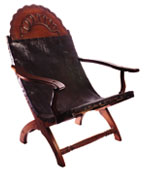 The
Campeachy Chair
The
Campeachy Chair
Not all the treasures of Firestone’s Department of Rare Books and Special Collections are textual. This leather-covered mahogany sling chair belonged to Samuel Stanhope Smith 1769, Princeton’s president from 1795 to 1812. Smith’s father was a prominent Presbyterian minister in Pennsylvania; Smith himself was ordained and later married a daughter of President Witherspoon. An energetic teacher and eloquent preacher, Smith was a handsome and worldly man who in our own time might have been a media cleric or professor.
This Campeachy chair was perfect seating for an academic notable of the new republic. The style originated in 16th-century Spain and spread to Mexico and the Mediterranean; the chair takes its name from Campeche in Yucatan, which is also a type of mahogany. It was especially popular in the coastal South, and Smith may have seen one as a young missionary and college instructor in Virginia. Thomas Jefferson ordered a Campeachy chair from New Orleans and had another made to his design by James Hemings, an enslaved master artisan and brother of Sally. The design was also James Madison 1771’s favorite. To Smith and his contemporaries, it must have seemed an irresistible mixture of Spanish dignity, luxurious New World materials, and tropical ease.
Smith’s charisma did not survive the student turmoil of the early 19th century. He lost the presidency, but the trustees awarded him a house and pension, and this chair was no doubt a great comfort.
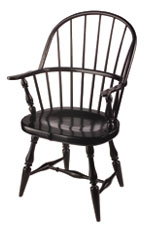 The
Windsor Chair
The
Windsor Chair
Invented by English wheelwrights who used their skills in turning and bending wood to assemble rugged but graceful plank-seated, spindle-backed chairs, Windsor chairs became American favorites. Windsor armchairs were used by the signers of the Declaration of Independence, and must have been common around the college, too. Enjoying ample wood and a growing market, Americans in the early republic soon were making more Windsor chairs than the British. Thomas Jefferson himself designed one equipped with a writing arm.
Nineteenth-century photographs of Princeton reveal a range of styles, high- and low-back. One popular American variety was the sack-back armchair. It had a U-shaped arm rail surmounted by a bow. Another was the tablet-top armchair with broad, usually curving surfaces, sometimes decorated, terminating the spindles at shoulder level. The former, revived in the mid-19th century, inspired seating now in use in the third-floor study area of Frist Campus Center (pictured here) and elsewhere. The latter, considered the Princeton chair, with the University seal engraved on the tablet, has been on sale at the U-Store for at least 40 years.
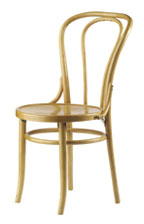 The
Café Chair
The
Café Chair
The Café Chair – now best known at Princeton as the seating in the Frist Campus Center food court – was an early pillar of mass industrial society. It was the idea of one of technology’s least appreciated innovators, Michael Thonet, a cabinetmaker from the Rhineland who was brought to Vienna by his appreciative patron, Prince Klemens von Metternich. Thonet plotted a manufacturing revolution and, using standardized forms to bend beech, he developed dozens of designs. The classic No. 14 — of which a variant is used today by Princeton diners — required only seven pieces of bentwood, 10 screws, and two washers, and manufacture was so simple that unskilled workers in Central Europe could learn the art. A century before Ikea, Thonet began to ship his crated sets of chair parts all over the world for easy assembly by dealers.
Eventually, the No. 14 became a favorite wherever inexpensive food and drink were sold. In Austria, a century ago, the chair cost no more than 10 liters of beer. Bentwood was one of the first miracle materials, lightweight and extremely strong, and as suitable for elegant rockers and lounge chairs as for basic seating. Unfortunately, the No. 14 provides no lumbar support, and the raised edge of the seat makes it uncomfortable in prolonged use – perhaps a feature rather than a bug for turnover-conscious proprietors.
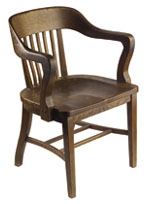 The
Bank of England Chair
The
Bank of England Chair
Bentwood and Windsor furniture had an elegant counterpart, an oak armchair with an elegantly curving rail and flat spindles fitting the contour of the back. An early printed reference to the chair occurs in an 1890 New York Times article describing the furnishings of a Pullman parlor car. By the turn of the century, Bank of England seats and arms were mounted on swivel bases with casters and were some of the most fashionable desk chairs.
The Bank of England chair was associated not only with financial institutions but with courts and other formal places; Yale Law School ordered many at the turn of the century. At Princeton the chairs were used for faculty seating, and remained evident well after World War II. A few turn up today in lecture halls and public rooms, but by the early 20th century, lecture halls in new buildings had built-in oak seats with writing arms. The Bank of England chair remains one of the best seats for preceptorials and seminars – tough but comfortably contoured.
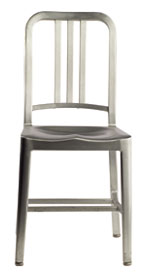 The
Emeco Aluminum Chair
The
Emeco Aluminum Chair
Recent arrivals on the Princeton campus, Emeco aluminum 1006 side chairs are now clustered between the television lounge and the Beverage Laboratory in the Frist Campus Center. It is made entirely of aluminum in a 77-step process developed in 1944 by a partnership of the Electric Machinery and Equipment Co. and Alcoa to supply seating for the Navy. Emeco’s founder was an engineer trained at Johns Hopkins who set up shop in the Amish country of Pennsylvania for its supply of skilled workers. Then as now, the chair was made in 12 sections, welded together and ground over and over until seams are undetectable, hardened by repeated heating and cooling until it is stronger than steel. The equipment that makes the chairs is durable, too; a 15-foot-high World War II-vintage press shapes the seat pan. The chair’s finish is said to be of near-diamond hardness.
Alumni who have worked in Firestone Library carrels will recognize the
upholstered versions of this chair, still fixtures after 45 years of continuous
use. (Life expectancy is said to be 150.) President Harold Dodds planned
the new building as a “laboratory-workshop” for independent
study and the senior thesis, and students were encouraged to work in open
stacks, a radical innovation at the time. The underground spaces were
like decks below the water line; the carrels were compact, almost nautical
enclosures. Navy seating must have looked right at home to veterans, and
their new seriousness was a match for Dodds’s goals.
![]()
Edward Tenner ’65 is a senior research associate of the Lemelson Center for the Study of Invention and Innovation at the Smithsonian Institution and author of Our Own Devices: The Past and Future of Body Technology (2003).
